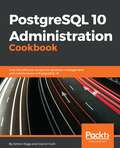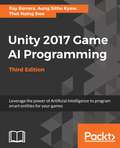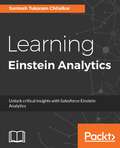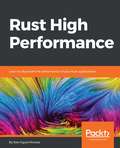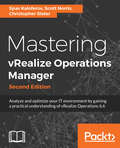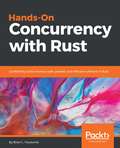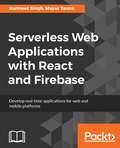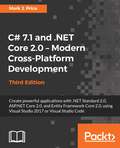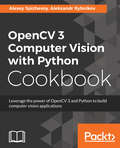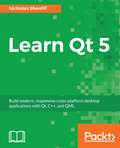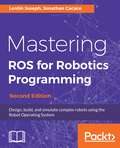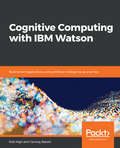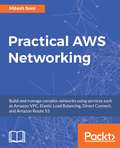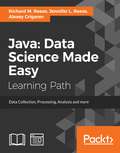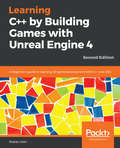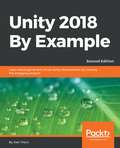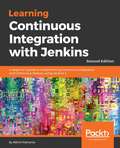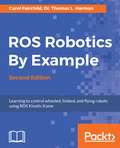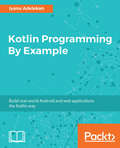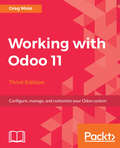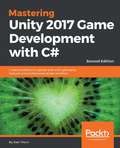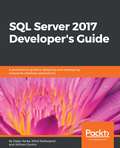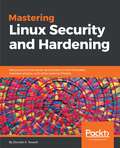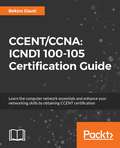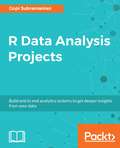- Table View
- List View
PostgreSQL 10 Administration Cookbook: Over 165 effective recipes for database management and maintenance in PostgreSQL 10
by Simon Riggs Gianni CiolliA practical guide to administer, monitor and replicate your PostgreSQL 10 databaseKey FeaturesGet to grips with the capabilities of PostgreSQL 10 to administer your database more efficientlyMonitor, tune, secure and protect your database for optimal performanceA step-by-step, recipe-based guide to help you tackle any problem in PostgreSQL 10 administration with easeBook DescriptionPostgreSQL is a powerful, open source database management system with an enviable reputation for high performance and stability. With many new features in its arsenal, PostgreSQL 10 allows users to scale up their PostgreSQL infrastructure. This book takes a step-by-step, recipe-based approach to effective PostgreSQL administration.Throughout this book, you will be introduced to these new features such as logical replication, native table partitioning, additional query parallelism, and much more. You will learn how to tackle a variety of problems that are basically the pain points for any database administrator - from creating tables to managing views, from improving performance to securing your database. More importantly, the book pays special attention to topics such as monitoring roles, backup, and recovery of your PostgreSQL 10 database, ensuring high availability, concurrency, and replication.By the end of this book, you will know everything you need to know to be the go-to PostgreSQL expert in your organization.What you will learnGet to grips with the newly released PostgreSQL 10 features to improve database performance and reliabilityManage open source PostgreSQL versions 10 on various platforms.Explore best practices for planning and designing live databasesSelect and implement robust backup and recovery techniques in PostgreSQL 10Explore concise and clear guidance on replication and high availabilityDiscover advanced technical tips for experienced usersWho this book is forThis book is for database administrators, data architects, developers, or anyone with an interest in planning for, or running, live production databases using PostgreSQL. It is most suited to those looking for hands-on solutions to any problem associated with PostgreSQL administration.
Unity 2017 Game AI Programming, Third Edition: Leverage The Power Of Artificial Intelligence To Program Smart Entities For Your Games
by Ray BarreraWhether you are developing traditional, serious, educational, or any other kind of game, understanding how to apply artificial intelligence can take the fun-factor to the next level! This book will not only uncover the newly released features in Unity 2017 but also teach you how to implement it in your game. Moreover, you will be working with different AI concepts and will help you to use it in your game to make it more awesome.
Learning Einstein Analytics: Unlock critical insights with Salesforce Einstein Analytics
by Santosh ChitalkarLearn to confidently setup and create app, lenses, dashboards using Salesforce Einstein Analytics. Key Features Explore Einstein analytics on desktop as well as mobile platforms Turn data into smarter sales with Einstein Analytics for Sales Visualize your data with preloaded as well as customized dashboards Book Description Salesforce Einstein analytics aka Wave Analytics is a cloud-based platform which connects data from the multiple sources and explores it to uncover insights. It empowers sales reps, marketers, and analysts with the insights to make customer interactions smarter, without building mathematical models. You will learn to create app, lenses, dashboards and share dashboards with other users. This book starts off with explaining you fundamental concepts like lenses, step, measures and sets you up with Einstein Analytics platform. We then move on to creating an app and here you will learn to create datasets, dashboards and different ways to import data into Analytics. Moving on we look at Einstein for sales, services, and marketing individually. Here you will learn to manage your pipeline, understand important business drivers and visualize trends. You will also learn features related to data monitoring tools and embedding dashboards with lightning, visualforce page and mobile devices. Further, you will learn advanced features pertaining to recent advancements in Einstein which include machine learning constructs and getting predictions for events. By the end of this book, you will become proficient in the Einstein analytics, getting insights faster and understanding your customer in a better way. What you will learn - Create app, lenses, and dashboards using Einstein. - Visualize data utilizing all the widgets available with Einstein. - Understand Einstein for Sales, Service, and Marketing separately. - Use Data monitoring tools to monitor data flow and system jobs. - Abstract machine learning constructs and make predictions on events Who this book is for This book is for data scientists, business users, developers who want to explore business data using the Salesforce Einstein Analytics. Knowledge of the Salesforce platform is required.
Rust High Performance: Learn to skyrocket the performance of your Rust applications
by Iban Eguia MorazaFind bottlenecks, identify the proper algorithm to use, optimize performance, and create really efficient Rust applicationsKey Features Understand common performance pitfalls and improve the performance of your applications. Get to grips with parallel programming and multithreading with Rust. Learn metaprogramming in Rust.Book DescriptionAt times, it is difficult to get the best performance out of Rust. This book teaches you to optimize the speed of your Rust code to the level of languages such as C/C++. You'll understand and fix common pitfalls, learn how to improve your productivity by using metaprogramming, and speed up your code by concurrently executing parts of it safely and easily. You will master the features of the language which will make you stand out and use them to really improve the efficiency of your algorithmsThe book begins with a gentle introduction to help you identify bottlenecks when programming in Rust. We highlight common performance pitfalls, along with strategies to detect and resolve these issues early. We move on to mastering Rust's type system, which will enable us to create impressive optimizations in both performance and safety at compile time. You will then learn how to effectively manage memory in Rust, mastering the borrow checker. We move on to measuring performance and you will see how this affects the way you write code. Moving ahead, you will perform metaprogramming in Rust to boost the performance of your code and your productivity. You will finally learn parallel programming in Rust, which enables efficient and faster execution by using multithreading and asynchronous programming.What you will learn Master tips and tricks to make your code faster. Learn how to identify bottlenecks in your Rust applications Discover how to profile your Rust software. Understand the type system to create compile-time optimizations. Master the borrow checker . Learn metaprogramming in Rust to avoid boilerplate code. Discover multithreading and work stealing in Rust. Understand asynchronous programming in Rust.Who this book is forThis book is for Rust developers keen to improve the speed of their code or simply to take their skills to the next level.
Mastering vRealize Operations Manager: Analyze and optimize your IT environment by gaining a practical understanding of vRealize Operations 6.6, 2nd Edition
by Scott Norris Spas Kaloferov Chris Slater Alasdair CarnieManage vRealize operations manager 6.6 effectively using this comprehensive guide.Key FeaturesGet complete control of capacity management in your virtual environmentDisplay the most appropriate performance metrics and assemble your own dashboardAnalyze and process data from different sources into a single repositoryOptimize vRealize Automation workload placement Book DescriptionIn the modern IT world, the criticality of managing the health, efficiency, and compliance of virtualized environments is more important than ever. With vRealize Operations Manager 6.6, you can make a difference to your business by being reactive rather than proactive.Mastering vRealize Operations Manager helps you streamline your processes and customize the environment to suit your needs. You will gain visibility across all devices in the network and retain full control. With easy-to-follow, step-by-step instructions and support images, you will quickly master the ability to manipulate your data and display it in a way that best suits you and your business or technical requirements. This book not only covers designing, installing, and upgrading vRealize Operations 6.6, but also gives you a deep understanding of its building blocks: badges, alerts, super metrics, views, dashboards, management packs, and plugins. With the new vRealize Operations 6.6 troubleshooting capabilities, capacity planning, intelligent workload placement, and additional monitoring capabilities, this book is aimed at ensuring you get the knowledge to manage your virtualized environment as effectively as possible.What you will learn Discover advanced vRealize Operations concepts and design your processes effectively for the underlying architecture Plan and install a new version or upgrade from a previous one Apply proven capacity management theories and techniques in practical, real-world environments Manipulate data and metrics to display them in the most effective way possible Create custom views and dashboards fit for any use case Explore how policies have evolved in vRealize Operations 6.6 and how to apply them in the most effective mannerWho this book is forIf you are an administrator of a virtual environment and have used vRealize Operations before but want to gain a professional understanding by easily implementing complex tasks with it, then this book is for you.
Hands-On Concurrency with Rust: Confidently build memory-safe, parallel, and efficient software in Rust
by Brian L. TroutwineGet to grips with modern software demands by learning the effective uses of Rust's powerful memory safety.Key Features Learn and improve the sequential performance characteristics of your software Understand the use of operating system processes in a high-scale concurrent system Learn of the various coordination methods available in the Standard library Book DescriptionMost programming languages can really complicate things, especially with regard to unsafe memory access. The burden on you, the programmer, lies across two domains: understanding the modern machine and your language's pain-points. This book will teach you to how to manage program performance on modern machines and build fast, memory-safe, and concurrent software in Rust. It starts with the fundamentals of Rust and discusses machine architecture concepts. You will be taken through ways to measure and improve the performance of Rust code systematically and how to write collections with confidence. You will learn about the Sync and Send traits applied to threads, and coordinate thread execution with locks, atomic primitives, data-parallelism, and more.The book will show you how to efficiently embed Rust in C++ code and explore the functionalities of various crates for multithreaded applications. It explores implementations in depth. You will know how a mutex works and build several yourself. You will master radically different approaches that exist in the ecosystem for structuring and managing high-scale systems. By the end of the book, you will feel comfortable with designing safe, consistent, parallel, and high-performance applications in Rust.What you will learn Probe your programs for performance and accuracy issues Create your own threading and multi-processing environment in Rust Use coarse locks from Rust’s Standard library Solve common synchronization problems or avoid synchronization using atomic programming Build lock-free/wait-free structures in Rust and understand their implementations in the crates ecosystem Leverage Rust’s memory model and type system to build safety properties into your parallel programs Understand the new features of the Rust programming language to ease the writing of parallel programsWho this book is forThis book is aimed at software engineers with a basic understanding of Rust who want to exploit the parallel and concurrent nature of modern computing environments, safely.
Serverless Web Applications with React and Firebase: Develop real-time applications for web and mobile platforms
by Harmeet Singh Mayur TannaBuild rich and collaborative applications using client-side code with React, Redux, and FirebaseKey Features1) A practical guide covering the full stack for web development with React 16 and Firebase2) Leverage the power of Firebase Cloud Storage, messaging, functions, OAuth, and database security to develop serverless web applications.3) Develop high-performance applications without the hassle of setting up complex web infrastructure.Book DescriptionReactJS is a wonderful framework for UI development. Firebase as a backend with React is a great choice as it is easy, powerful, and provides great developer experience. It removes a lot of boilerplate code from your app and allows you to focus on your app to get it out quickly to users. Firebase with React is also a good choice for Most Viable Product (MVP) development.This book provides more practical insights rather than just theoretical concepts and includes basic to advanced examples – from hello world to a real-time seat booking app and Helpdesk applicationThis book will cover the essentials of Firebase and React.js and will take you on a fast-paced journey through building real-time applications with Firebase features such as Cloud Storage, Cloud Function, Hosting and the Realtime Database. We will learn how to secure our application by using Firebase authentication and database security rules. We will leverage the power of Redux to organize data in the front-end, since Redux attempts to make state mutations predictable by imposing certain restrictions on how and when updates can happen. Towards the end of the book you will have improved your React skills by realizing the potential of Firebase to create real-time serverless web applications.What you will learnInstall powerful React.js and Firebase tools to make development much more efficientCreate React components with Firebase to save and retrieve the data in real-timeUse Firebase Authentication to make your React user interface secureDevelop React and Firebase applications with Redux integration Firebase database security rulesFirebase Cloud Storage Integration to upload and store data on the cloudCreate a complete real-time application with React and firebaseUsing Firebase Cloud messaging and Cloud functions with ReactFirebase Cloud Storage integration with ReactWho this book is forThis book is for JavaScript developers who have some previous knowledge of React and want to develop serverless, full-stack applications but without the hassle of setting up a complex infrastructure.
C# 7.1 and .NET Core 2.0 – Modern Cross-Platform Development - Third Edition
by Mark J. PriceC# 7.1 and .NET Core 2.0 – Modern Cross-Platform Development, Third Edition is a practical guide to creating powerful cross-platform applications with C# 7 and .NET Core 2.0. About This Book • Build modern, cross-platform applications with .NET Core 2.0 • Get up to speed with C#, and up to date with all the latest features of C# 7.1 • Start creating professional web applications with ASP.NET Core 2.0 Who This Book Is For This book is targeted towards readers who have some prior programming experience or have a science, technology, engineering, or mathematics (STEM) background, and want to gain a solid foundation with C# and to be introduced to the types of applications they could build and will work cross-platform on Windows, Linux, and macOS. What You Will Learn • Build cross-platform applications using C# 7.1 and .NET Core 2.0 • Explore ASP.NET Core 2.0 and learn how to create professional websites, services, and applications • Improve your application's performance using multitasking • Use Entity Framework Core and LINQ to query and manipulate data • Master object-oriented programming with C# to increase code reuse and efficiency • Familiarize yourself with cross-device app development using the Universal Windows Platform • Protect and manage your files and data with encryption, streams, and serialization • Get started with mobile app development using Xamarin.Forms • Preview the nullable reference type feature of C# 8 In Detail C# 7.1 and .NET Core 2.0 – Modern Cross-Platform Development, Third Edition, is a practical guide to creating powerful cross-platform applications with C# 7.1 and .NET Core 2.0. It gives readers of any experience level a solid foundation in C# and .NET. The first part of the book runs you through the basics of C#, as well as debugging functions and object-oriented programming, before taking a quick tour through the latest features of C# 7.1 such as default literals, tuples, inferred tuple names, pattern matching, out variables, and more. After quickly taking you through C# and how .NET works, this book dives into the .NET Standard 2.0 class libraries, covering topics such as packaging and deploying your own libraries, and using common libraries for working with collections, performance, monitoring, serialization, files, databases, and encryption. The final section of the book demonstrates the major types of application that you can build and deploy cross-device and cross-platform. In this section, you'll learn about websites, web applications, web services, Universal Windows Platform (UWP) apps, and mobile apps. By the end of the book, you'll be armed with all the knowledge you need to build modern, cross-platform applications using C# and .NET. Style and approach This book takes a step-by-step approach and is filled with exciting projects and fascinating theory. It uses three high-impact sections to equip you with all the tools you'll need to build modern, cross-platform applications using C# and .NET Core 2.0.
OpenCV 3 Computer Vision with Python Cookbook: Leverage the power of OpenCV 3 and Python to build computer vision applications
by Aleksei Spizhevoi Aleksandr RybnikovRecipe-based approach to tackle the most common problems in Computer Vision by leveraging the functionality of OpenCV using Python APIsKey Features●Build computer vision applications with OpenCV functionality via Python API●Get to grips with image processing, multiple view geometry, and machine learning●Learn to use deep learning models for image classification, object detection, and face recognitionBook DescriptionOpenCV 3 is a native cross-platform library for computer vision, machine learning, and image processing. OpenCV's convenient high-level APIs hide very powerful internals designed for computational efficiency that can take advantage of multicore and GPU processing. This book will help you tackle increasingly challenging computer vision problems by providing a number of recipes that you can use to improve your applications.In this book, you will learn how to process an image by manipulating pixels and analyze an image using histograms. Then, we'll show you how to apply image filters to enhance image content and exploit the image geometry in order to relay different views of a pictured scene. We’ll explore techniques to achieve camera calibration and perform a multiple-view analysis.Later, you’ll work on reconstructing a 3D scene from images, converting low-level pixel information to high-level concepts for applications such as object detection and recognition. You’ll also discover how to process video from files or cameras and how to detect and track moving objects. Finally, you'll get acquainted with recent approaches in deep learning and neural networks.By the end of the book, you’ll be able to apply your skills in OpenCV to create computer vision applications in various domains.What you will learn●Get familiar with low-level image processing methods●See the common linear algebra tools needed in computer vision●Work with different camera models and epipolar geometry●Find out how to detect interesting points in images and compare them●Binarize images and mask out regions of interest●Detect objects and track them in videosWho this book is forThis book is for developers who have a basic knowledge of Python. If you are aware of the basics of OpenCV and are ready to build computer vision systems that are smarter, faster, more complex, and more practical than the competition, then this book is for you.
Learn Qt 5: Build Modern, Responsive Cross-platform Desktop Applications With Qt, C++, And Qml
by Nicholas SherriffQt is a mature and powerful framework for delivering sophisticated applications across a multitude of platforms. It has a rich history in the Linux world, is widely used in embedded devices and has made great strides in the Mobile arena over the past few years. However, in the Microsoft Windows and Apple Mac OS X worlds, the dominance of C#/.NET and Objective-C/Cocoa mean that Qt is often overlooked.) solution from scratch, with distinct library, user interface and unit test projects.
Mastering ROS for Robotics Programming, Second Edition: Design, Build, And Simulate Complex Robots Using The Robot Operating System
by Jonathan Cacace<P><P>Discover best practices and troubleshooting solutions when working on ROS <P><P>Key Features <P><P>Develop complex robotic applications using ROS to interface robot manipulators and mobile robots <P><P>Gain insight into autonomous navigation in mobile robots and motion planning in robot manipulators <P><P>Discover best practices and troubleshooting solutions <P><P>Book Description <P><P>In this day and age, robotics has been gaining a lot of traction in various industries where consistency and perfection matter. Automation is achieved via robotic applications and various platforms that support robotics. The Robot Operating System (ROS) is a modular software platform to develop generic robotic applications. This book focuses on the most stable release of ROS (Kinetic Kame), discusses advanced concepts, and effectively teaches you programming using ROS. <P><P>We begin with aninformative overview of the ROS framework, which will give you a clear idea of how ROS works. During the course of this book, you'll learn to build models of complex robots, and simulate and interface the robot using the ROS MoveIt! motion planning library and ROS navigation stacks. Learn to leverage several ROS packages to embrace your robot models. <P><P>After covering robot manipulation and navigation, you'll get to grips with the interfacing I/O boards, sensors, and actuators of ROS. Vision sensors are a key component of robots, and an entire chapter is dedicated to the vision sensor and image elaboration, its interface in ROS and programming. You'll also understand the hardware interface and simulation of complex robots to ROS and ROS Industrial. <P><P>At the end of this book, you'll discover the best practices to follow when programming using ROS. <P><P>What you will learn <P><P>Create a robot model with a seven-DOF robotic arm and a differential wheeled mobile robot <P><P>Work with Gazebo and V-REP robotic simulator <P><P>Implement autonomous navigation in differential drive robots using SLAM and AMCL packages <P><P>Explore the ROS Pluginlib, ROS nodelets, and Gazebo plugins <P><P>Interface I/O boards such as Arduino, robot sensors, and high-end actuators <P><P>Simulate and motion plan an ABB and universal arm using ROS Industrial <P><P>Explore the latest version of the ROS framework <P><P>Work with the motion planning of a seven-DOF arm using MoveIt! <P><P>Who This Book Is For <P><P>If you are a robotics enthusiast or researcher who want to learn more about building robot applications using ROS, this book is for you. In order to learn from this book, you should have a basic knowledge of ROS, GNU/Linux, and C++ programming concepts. The book is also excellent for programmers who want to explore the advanced features of ROS.
Cognitive Computing with IBM Watson: Build smart applications using artificial intelligence as a service
by Rob High Tanmay BakshiUnderstand, design, and create cognitive applications using Watson’s suite of APIs.Key FeaturesDevelop your skills and work with IBM Watson APIs to build efficient and powerful cognitive appsLearn how to build smart apps to carry out different sets of activities using real-world use casesGet well versed with the best practices of IBM Watson and implement them in your daily workBook DescriptionCognitive computing is rapidly infusing every aspect of our lives riding on three important fields: data science, machine learning (ML), and artificial intelligence (AI). It allows computing systems to learn and keep on improving as the amount of data in the system grows.This book introduces readers to a whole new paradigm of computing – a paradigm that is totally different from the conventional computing of the Information Age. You will learn the concepts of ML, deep learning (DL), neural networks, and AI through the set of APIs provided by IBM Watson. This book will help you build your own applications to understand, plan, and solve problems, and analyze them as per your needs. You will learn about various domains of cognitive computing, such as NLP, voice processing, computer vision, emotion analytics, and conversational systems, using different IBM Watson APIs.From this, the reader will learn what ML is, and what goes on in the background to make computers "do their magic," as well as where these concepts have been applied. Having achieved this, the readers will then be able to embark on their journey of learning, researching, and applying the concept in their respective fields.What you will learnGet well versed with the APIs provided by IBM Watson on IBM CloudLearn ML, AI, cognitive computing, and neural network principlesImplement smart applications in fields such as healthcare, entertainment, security, and moreUnderstand unstructured content using cognitive metadata with the help of Natural Language UnderstandingUse Watson’s APIs to create real-life applications to realize their capabilitiesDelve into various domains of cognitive computing, such as media analytics, embedded deep learning, computer vision, and moreWho this book is forThis book is for beginners and novices; having some knowledge about artificial intelligence and deep learning is an advantage, but not a prerequisite to benefit from this book. We explain the concept of deep learning and artificial intelligence through the set of tools IBM Watson provides.
Practical AWS Networking: Build and manage complex networks using services such as Amazon VPC, Elastic Load Balancing, Direct Connect, and Amazon Route 53
by Mitesh Soni Zoltan Altfatter Adrin MukherjeeKey Features Master your networking skills on Public Cloud. Gain hands-on experience of using Amazon VPC, Elastic Load Balancing, Direct Connect and other AWS products. Implement troubleshooting skills and best practices for security on AWS network. Book Description Amazon Web Services (AWS) dominates the public cloud market by a huge margin and it continues to be the first choice for many organizations. Networking has been an area of focus for all the leading cloud service providers. AWS has a suite of network-related products that help to perform network-related task in AWS. This book initially covers the basics of networking in AWS. Then we use AWS VPC to create an isolated virtual cloud for performing network-related tasks. We then provide an overview of AWS Direct Connect after taking a deep dive into scalability and load balancing using Auto scaling feature, Elastic Load Balancing, and Amazon Route S3. Toward the end of the book, we cover some troubleshooting tips and security best practices for your network. By the end of this book, you will have hands-on experience of working with network tasks on AWS. What you will learn Overview of all networking services available in AWS. Gain Work with load balance application across different regions. Learn auto scale instance based on the increase and decrease of the traffic. Deploy application in highly available and fault tolerant manner. Configure Route 53 for a web application. Troubleshooting tips and best practices at the end
Java: Data Science Made Easy
by Richard M. Reese Jennifer L. Reese Alexey GrigorevData collection, processing, analysis, and more About This Book • Your entry ticket to the world of data science with the stability and power of Java • Explore, analyse, and visualize your data effectively using easy-to-follow examples • A highly practical course covering a broad set of topics - from the basics of Machine Learning to Deep Learning and Big Data frameworks. Who This Book Is For This course is meant for Java developers who are comfortable developing applications in Java, and now want to enter the world of data science or wish to build intelligent applications. Aspiring data scientists with some understanding of the Java programming language will also find this book to be very helpful. If you are willing to build efficient data science applications and bring them in the enterprise environment without changing your existing Java stack, this book is for you! What You Will Learn • Understand the key concepts of data science • Explore the data science ecosystem available in Java • Work with the Java APIs and techniques used to perform efficient data analysis • Find out how to approach different machine learning problems with Java • Process unstructured information such as natural language text or images, and create your own searc • Learn how to build deep neural networks with DeepLearning4j • Build data science applications that scale and process large amounts of data • Deploy data science models to production and evaluate their performance In Detail Data science is concerned with extracting knowledge and insights from a wide variety of data sources to analyse patterns or predict future behaviour. It draws from a wide array of disciplines including statistics, computer science, mathematics, machine learning, and data mining. In this course, we cover the basic as well as advanced data science concepts and how they are implemented using the popular Java tools and libraries.The course starts with an introduction of data science, followed by the basic data science tasks of data collection, data cleaning, data analysis, and data visualization. This is followed by a discussion of statistical techniques and more advanced topics including machine learning, neural networks, and deep learning. You will examine the major categories of data analysis including text, visual, and audio data, followed by a discussion of resources that support parallel implementation. Throughout this course, the chapters will illustrate a challenging data science problem, and then go on to present a comprehensive, Java-based solution to tackle that problem. You will cover a wide range of topics – from classification and regression, to dimensionality reduction and clustering, deep learning and working with Big Data. Finally, you will see the different ways to deploy the model and evaluate it in production settings. By the end of this course, you will be up and running with various facets of data science using Java, in no time at all. This course contains premium content from two of our recently published popular titles: • Java for Data Science • Mastering Java for Data Science Style and approach This course follows a tutorial approach, providing examples of each of the concepts covered. With a step-by-step instructional style, this book covers various facets of data science and will get you up and running quickly.
Learning C++ by Creating Games with Unreal Engine 4 - Second Edition
by Sharan VolinIf you are really passionate about games and have always wanted to write your own, this book is perfect for you. It will help you get started with programming in C++ and explore the immense functionalities of UE4
Unity 2018 By Example: Learn about game and virtual reality development by creating five engaging projects, 2nd Edition
by Alan ThornBuild exciting 2D/3D games and virtual reality applications with the help of hands-on examplesKey FeaturesCreate five different types of games from scratch with Unity 2018Import custom content into Unity from third-party tools such as Maya and Blender Learn to build NPCs with artificial intelligent behavior. Book DescriptionUnity is the most exciting and popular engine used for developing games. With its 2018 release, Unity has become the primary source of both game development and virtual reality content.In Unity 2018 By Example, you’ll learn how to use Unity in order to make amazing games from popular genres - from action shooters to mind-bending puzzle games to adventure and Virtual Reality (VR) games. Even if you have no previous experience of using Unity, this book will help you understand the toolsets it provides in depth. In addition to this, you'll understand how to create time-critical collection games, twin-stick space shooters, platformers, and action-fest games with intelligent enemies. Finally, you'll get to grips with creating VR games with the new toolsets introduced by Unity to help you develop amazing VR experiences.To make things easier, you will be provided with step-by-step tutorials for making five great games in Unity 2018, along with a detailed explanation of all the fundamental concepts. By the end of this book, you’ll have established a strong foundation in making games with Unity 2018.What you will learnUnderstand core Unity concepts, such as game objects, components, and scenesStudy level-design techniques for building immersive and interesting worldsMake functional games with C# scriptingUse the toolset creatively to build games with different themes and stylesHandle player controls and input functionalityWork with terrains and world-creation toolsGet to grips with making both 2D and 3D gamesWho this book is forYou don't need to have any previous experience with Unity to enjoy Unity 2018 By Example, although you need to have basic knowledge of C#.
Learning Continuous Integration with Jenkins: A Beginner's Guide To Implementing Continuous Integration And Continuous Delivery Using Jenkins 2
by Nikhil PathaniaA step-by-step guide to quickly set up Jenkins across various platforms and create a Continuous Integration and Continuous Delivery pipeline using all the new features introduced in Jenkins 2.x such as Pipeline as a Code, Multibranch pipeline, Blue Ocean Plugin, and more.
ROS Robotics By Example Second Edition
by Carol Fairchild Thomas L. HarmanLearning how to build and program your own robots with the most popular open source robotics programming frameworkAbout This Book* Get to know the fundamentals of ROS and apply its concepts to real examples* Learn how to write robotics applications without getting bogged down in hardware problems* Learn to implement best practices in ROS development Who This Book Is ForThis book is for robotic enthusiasts, researchers and professional robotics engineers who would like to build robot applications using ROS. It gives the robotics beginner and the ROS newbie an immensely practical introduction to robot building and robotics application coding. Basic knowledge of GNU/Linux and the ability to write simple applications is assumed, but no robotics knowledge, practical or theoretical, is needed.What You Will Learn* Control a robot without requiring a PhD in robotics* Simulate and control a robot arm* Control a flying robot* Send your robot on an independent mission* Learning how to control your own robots with external devices* Program applications running on your robot* Extend ROS itself* Extend ROS with the MATLAB Robotics System ToolboxIn DetailROS is a robust robotics framework that works regardless of hardware architecture or hardware origin. It standardizes most layers of robotics functionality from device drivers to process control and message passing to software package management.But apart from just plain functionality, ROS is a great platform to learn about robotics itself and to simulate, as well as actually build, your first robots. This does not mean that ROS is a platform for students and other beginners; on the contrary, ROS is used all over the robotics industry to implement flying, walking and diving robots, yet implementation is always straightforward, and never dependent on the hardware itself.ROS Robotics has been the standard introduction to ROS for potential professionals and hobbyists alike since the original edition came out; the second edition adds a gradual introduction to all the goodness available with the Kinetic Kame release.By providing you with step-by-step examples including manipulator arms and flying robots, the authors introduce you to the new features. The book is intensely practical, with space given to theory only when absolutely necessary. By the end of this book, you will have hands-on experience on controlling robots with the best possible framework.Style and approachROS Robotics By Example, Second Edition gives the robotics beginner as well as the ROS newbie an immensely practical introduction to robot building and robotics application coding. ROS translates as "robot operating system"; you will learn how to control a robot via devices and configuration files, but you will also learn how to write robot applications on the foundation of this operating system.
Kotlin Programming By Example: Build real-world Android and web applications the Kotlin way
by Iyanu AdelekanEnhance your Kotlin programming skills by building 3 real-world applicationsKey FeaturesBuild three full-fledged, engaging applications from scratch and learn to deploy themEnhance your app development and programming activities with Kotlin’s powerful and intuitive tools and utilities.Experience the gentle learning curve, expressiveness, and intuitiveness of Kotlin, as you develop your own applicationsBook DescriptionKotlin greatly reduces the verbosity of source code. With Google having announced their support for Kotlin as a first-class language for writing Android apps, now's the time learn how to create apps from scratch with KotlinKotlin Programming By Example takes you through the building blocks of Kotlin, such as functions and classes. You’ll explore various features of Kotlin by building three applications of varying complexity. For a quick start to Android development, we look at building a classic game, Tetris, and elaborate on object-oriented programming in Kotlin. Our next application will be a messenger app, a level up in terms of complexity. Before moving onto the third app, we take a look at data persistent methods, helping us learn about the storage and retrieval of useful applications. Our final app is a place reviewer: a web application that will make use of the Google Maps API and Place Picker.By the end of this book, you will have gained experience of of creating and deploying Android applications using Kotlin.What you will learnLearn the building blocks of the Kotlin programming languageDevelop powerful RESTful microservices for Android applicationsCreate reactive Android applications efficientlyImplement an MVC architecture pattern and dependency management using KotlinCentralize, transform, and stash data with LogstashSecure applications using Spring SecurityDeploy Kotlin microservices to AWS and Android applications to the Play StoreWho this book is forThis book is for those who are new to Kotlin or are familiar with the basics, having dabbled with Java until now. Basic programming knowledge is mandatory.
Working with Odoo 11: Configure, manage, and customize your Odoo system, 3rd Edition
by Greg MossTransform and modernize your businesses and upgrade your enterprise management skills with Odoo 11, the most comprehensive management softwareKey FeaturesUse project management along with analytics for better reportingBuild an Odoo module and integrate it with other platforms with this practical guideExplore new design and mobile updates from the Odoo enterpriseBook DescriptionOdoo is an all-in-one management software that offers an array of business applications, forming a complete suite of enterprise management applications. Odoo 11 comes with advances on usability, speed, and design.Working with Odoo 11 starts with how to set up Odoo, both online and on your own server. You’ll then configure the basic company settings required to quickly get your first Odoo system up and running. Later, you’ll explore customer relationship management in Odoo and its importance in a modern business environment. You'll then dive into purchasing applications with Odoo, learn some of the primary functionalities of ERP systems for manufacturing operations, and use analytic accounting to provide better reporting. After that, you'll learn how to work with Odoo for mobile, and finally, you will walk through the recent Odoo 11 features with respect to the community and enterprise edition, giving you a complete understanding of what Odoo can do for your business.What you will learnConfigure a functioning customer relationship management systemSet up a purchasing and receiving systemImplement manufacturing operations and processes using real-world examplesDiscover the capabilities of Odoo's financial accounting and reporting featuresIntegrate powerful human resource applicationsUtilize Odoo's project management application to organize tasksCustomize Odoo without writing a line of codeWho this book is forThis book is for beginners, and will help you learn advanced-level features with Odoo such as creating your own custom modules. You do not need any prior knowledge of Odoo.
Mastering Unity 2017 Game Development with C#
by Alan ThornDo you want to take the leap from being an everyday Unity developer to being a pro game developer? Then look no further! This book is your one stop solution to creating mesmerizing games with lifelike features and amazing gameplay. This book takes an in-depth focus on a practical project with Unity, building a first-person game with many features. You will make the most of the Unity 2017 advanced features while you develop the game in its entirety.
SQL Server 2017 Developer’s Guide: A professional guide to designing and developing enterprise database applications
by Miloš Radivojević William Durkin Dejan SarkaBuild smarter and efficient database application systems for your organization with SQL Server 2017Key FeaturesBuild database applications by using the development features of SQL Server 2017Work with temporal tables to get information stored in a table at any time Use adaptive querying to enhance the performance of your queriesBook DescriptionMicrosoft SQL Server 2017 is the next big step in the data platform history of Microsoft as it brings in the power of R and Python for machine learning and containerization-based deployment on Windows and Linux. Compared to its predecessor, SQL Server 2017 has evolved into Machine Learning with R services for statistical analysis and Python packages for analytical processing. This book prepares you for more advanced topics by starting with a quick introduction to SQL Server 2017’s new features and a recapitulation of the possibilities you may have already explored with previous versions of SQL Server. The next part introduces you to enhancements in the Transact-SQL language and new database engine capabilities and then switches to a completely new technology inside SQL Server: JSON support. We also take a look at the Stretch database, security enhancements, and temporal tables.Furthermore, the book focuses on implementing advanced topics, including Query Store, columnstore indexes, and In-Memory OLTP. Towards the end of the book, you’ll be introduced to R and how to use the R language with Transact-SQL for data exploration and analysis. You’ll also learn to integrate Python code in SQL Server and graph database implementations along with deployment options on Linux and SQL Server in containers for development and testing. By the end of this book, you will have the required information to design efficient, high-performance database applications without any hassle.What you will learn Explore the new development features introduced in SQL Server 2017 Identify opportunities for In-Memory OLTP technology Use columnstore indexes to get storage and performance improvements Exchange JSON data between applications and SQL Server Use the new security features to encrypt or mask the data Control the access to the data on the row levels Discover the potential of R and Python integration Model complex relationships with the graph databases in SQL Server 2017Who this book is forDatabase developers and solution architects looking to design efficient database applications using SQL Server 2017 will find this book very useful. In addition, this book will be valuable to advanced analysis practitioners and business intelligence developers. Database consultants dealing with performance tuning will get a lot of useful information from this book as well.Some basic understanding of database concepts and T-SQL is required to get the best out of this book.
Mastering Linux Security and Hardening: Secure Your Linux Server And Protect It From Intruders, Malware Attacks, And Other External Threats
by Donald A. TevaultFor the past couple of decades, Linux has been extremely popular with systems administrators, for everything from creating networks and servers to automating their entire working environment. However, security has always been the major concern. With not many resources available in the Linux security domain, this book will be an invaluable resource to help you get your Linux systems properly secured.
CCENT/CCNA: Learn computer network essentials and enhance your networking skills by obtaining the CCENT certification
by Bekim DautiBecome familiar with ICND1 (100-105) exam objectives, and learn how to get ready for the examKey FeaturesA step by step guide that will build you skills from basic concepts to completely understanding network communicationComprehensive coverage to help you implement the knowledge you've gained in real-world scenariosTake practice questions and mock tests to check how prepared you are for the CCENT examBook DescriptionCCENT is the entry-level certification for those looking to venture into the networking world. This guide will help you stay up-to date with your networking skills. This book starts with the basics and will take you through everything essential to pass the certification exam. It extensively covers IPv4 and IPv6 addressing, IP data networks, switching and routing, network security, and much more—all in some detail. This guide will provide real-world examples with a bunch of hands-on labs to give you immense expertise in important networking tasks, with a practical approach. Each chapter consists of practice questions to help you take up a challenge from what you have procured. This book ends with mock tests with several examples to help you confidently pass the certification. This Certification Guide consists of everything you need to know in order to pass the ICND 1 100-105 Exam, thus obtaining a CCENT certification. However, practicing with real switches and routers or a switch or router simulator will help you succeed.What you will learnGet to grips with the computer network conceptsUnderstand computer network components and learn to create a computer networkUnderstand switching and learn how to configure a switchUnderstand routing and learn how to configure a routerUnderstand network services and the maintenance processLearn how to troubleshoot networking issuesBecome familiar with, and learn how to prepare for, the ICND1 100-105 examWho this book is forIf you are a Network Administrator, Network Technician, Networking professional, or would simply like to prepare for your CCENT certification, then this book is for you. Some basic understanding of networks and how they work would be helpful. Sufficient information will be provided to those new to this field.
R Data Analysis Projects
by Gopi SubramanianGet valuable insights from your data by building data analysis systems from scratch with R. About This Book • A handy guide to take your understanding of data analysis with R to the next level • Real-world projects that focus on problems in finance, network analysis, social media, and more • From data manipulation to analysis to visualization in R, this book will teach you everything you need to know about building end-to-end data analysis pipelines using R Who This Book Is For If you are looking for a book that takes you all the way through the practical application of advanced and effective analytics methodologies in R, then this is the book for you. A fundamental understanding of R and the basic concepts of data analysis is all you need to get started with this book. What You Will Learn • Build end-to-end predictive analytics systems in R • Build an experimental design to gather your own data and conduct analysis • Build a recommender system from scratch using different approaches • Use and leverage RShiny to build reactive programming applications • Build systems for varied domains including market research, network analysis, social media analysis, and more • Explore various R Packages such as RShiny, ggplot, recommenderlab, dplyr, and find out how to use them effectively • Communicate modeling results using Shiny Dashboards • Perform multi-variate time-series analysis prediction, supplemented with sensitivity analysis and risk modeling In Detail R offers a large variety of packages and libraries for fast and accurate data analysis and visualization. As a result, it's one of the most popularly used languages by data scientists and analysts, or anyone who wants to perform data analysis. This book will demonstrate how you can put to use your existing knowledge of data analysis in R to build highly efficient, end-to-end data analysis pipelines without any hassle. You'll start by building a content-based recommendation system, followed by building a project on sentiment analysis with tweets. You'll implement time-series modeling for anomaly detection, and understand cluster analysis of streaming data. You'll work through projects on performing efficient market data research, building recommendation systems, and analyzing networks accurately, all provided with easy to follow codes. With the help of these real-world projects, you'll get a better understanding of the challenges faced when building data analysis pipelines, and see how you can overcome them without compromising on the efficiency or accuracy of your systems. The book covers some popularly used R packages such as dplyr, ggplot2, RShiny, and others, and includes tips on using them effectively. By the end of this book, you'll have a better understanding of data analysis with R, and be able to put your knowledge to practical use without any hassle. Style and approach This book takes a unique, learn-as-you-do approach, as you build on your understanding of data analysis progressively with each project. This book is designed in a way that implementing each project will empower you with a unique skill set, and enable you to implement the next project more confidently.
